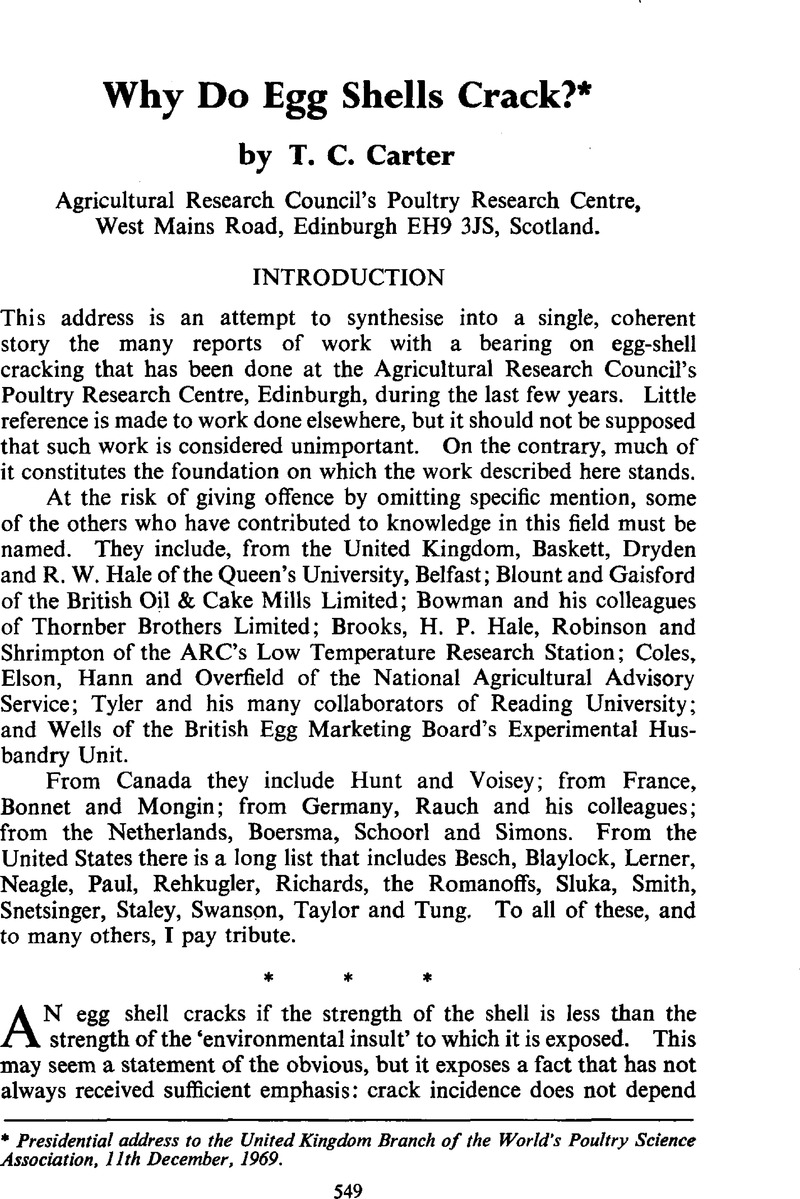Crossref Citations
This article has been cited by the following publications. This list is generated based on data provided by Crossref.
Carter, T. C.
1970.
The Hen's egg: Factors affecting the shearing strength of shell material.
British Poultry Science,
Vol. 11,
Issue. 4,
p.
433.
Carter, T. C.
1971.
The Hen's egg: Variation in tensile strength of shell material and its relationship with shearing strength.
British Poultry Science,
Vol. 12,
Issue. 1,
p.
57.
Nethercote, C.H.
Boisvenu, C.N.
and
Fletcher, D.A.
1974.
Egg Carton Tests.
Poultry Science,
Vol. 53,
Issue. 1,
p.
311.
VOISEY, PETER W.
and
HUNT, J. R.
1974.
MEASUREMENT OF EGGSHELL STRENGTH*.
Journal of Texture Studies,
Vol. 5,
Issue. 2,
p.
135.
Voisey, P. W.
and
Hamilton, R. M. G.
1975.
Behaviour of egg shell under compression in relation to deformation measurements1.
British Poultry Science,
Vol. 16,
Issue. 5,
p.
461.
Voisey, P. W.
and
Hamilton, R. M. G.
1976.
Factors affecting the non‐destructive and destructive methods of measuring egg shell strength by the quasi‐static compression test1.
British Poultry Science,
Vol. 17,
Issue. 1,
p.
103.
Pevzner, I. Y.
Friars, G. W.
Orr, H. L.
and
Reinhart, B. S.
1976.
The use of selection and strain crossing to reduce egg shell breakage.
British Poultry Science,
Vol. 17,
Issue. 2,
p.
185.
Carter, T. C.
1976.
The hen's EGG: Shell forces at impact and quasi‐static compression.
British Poultry Science,
Vol. 17,
Issue. 2,
p.
199.
Hamilton, R. M. G.
Hollands, K. G.
Voisey, P. W.
and
Grunder, A. A.
1979.
Relationship Between Egg Shell Quality and Shell Breakage and Factors that Affect Shell Breakage in the Field–A Review.
World's Poultry Science Journal,
Vol. 35,
Issue. 3,
p.
177.
Belyavin, C. G.
and
Boorman, K. N.
1980.
The influence of the cuticle on egg‐shell strength.
British Poultry Science,
Vol. 21,
Issue. 4,
p.
295.
Belyavin, G. G.
and
Boorman, K. N.
1981.
Physical characteristics of intact and cracked eggs.
British Poultry Science,
Vol. 22,
Issue. 1,
p.
9.
Hunton, Peter
1982.
Genetic Factors Affecting Egg Shell Quality.
World's Poultry Science Journal,
Vol. 38,
Issue. 2,
p.
75.
Schoorl, D.
and
Holt, J.E.
1983.
Mechanical damage in agricultural products: A basis for management.
Agricultural Systems,
Vol. 11,
Issue. 3,
p.
143.
Hughes, R. J.
1988.
Inter-relationships between egg shell quality, blood acid-base balance and dietary electrolytes.
World's Poultry Science Journal,
Vol. 44,
Issue. 1,
p.
30.
Bain, M. M.
1992.
Eggshell strength: A relationship between the mechanism of failure and the ultrastructural organisation of the mammillary layer.
British Poultry Science,
Vol. 33,
Issue. 2,
p.
303.
Solomon, S. E.
Bain, M. M.
Cranstoun, S.
and
Nascimento, V.
1994.
Microbiology of the Avian Egg.
p.
1.
Hunton, Peter
1995.
Understanding the architecture of the egg shell.
World's Poultry Science Journal,
Vol. 51,
Issue. 2,
p.
141.
Solomon, S. E.
1999.
An egg ist ein ei, es un huevo, est un oeuf.
British Poultry Science,
Vol. 40,
Issue. 1,
p.
5.
Hunton, P
2005.
Research on eggshell structure and quality: an historical overview.
Revista Brasileira de Ciência Avícola,
Vol. 7,
Issue. 2,
p.
67.
Orlova, Yevgeniya
Linker, Raphael
and
Spektor, Boris
2012.
Expansion of cracks in chicken eggs exposed to sub-atmospheric pressure.
Biosystems Engineering,
Vol. 112,
Issue. 4,
p.
278.





